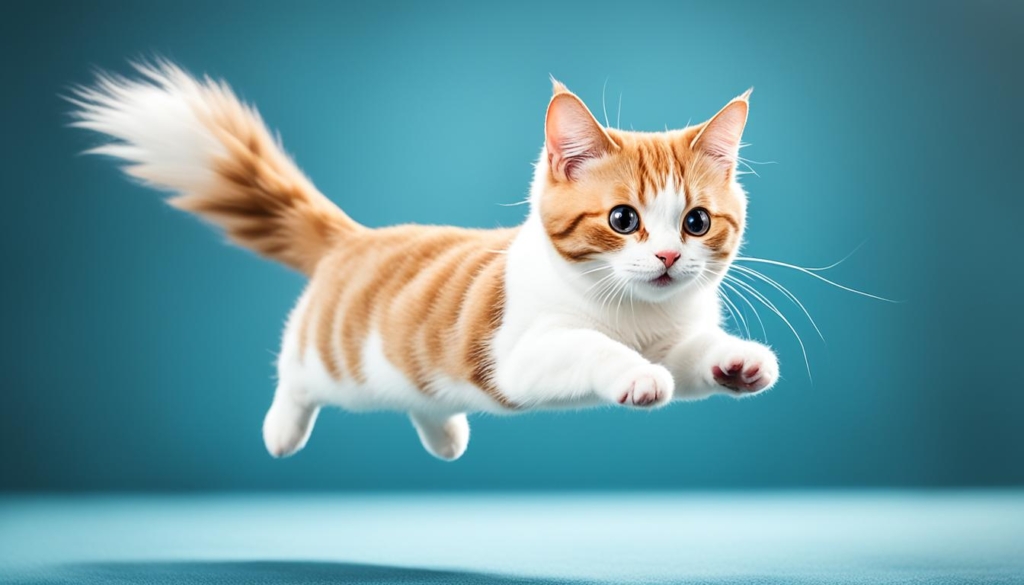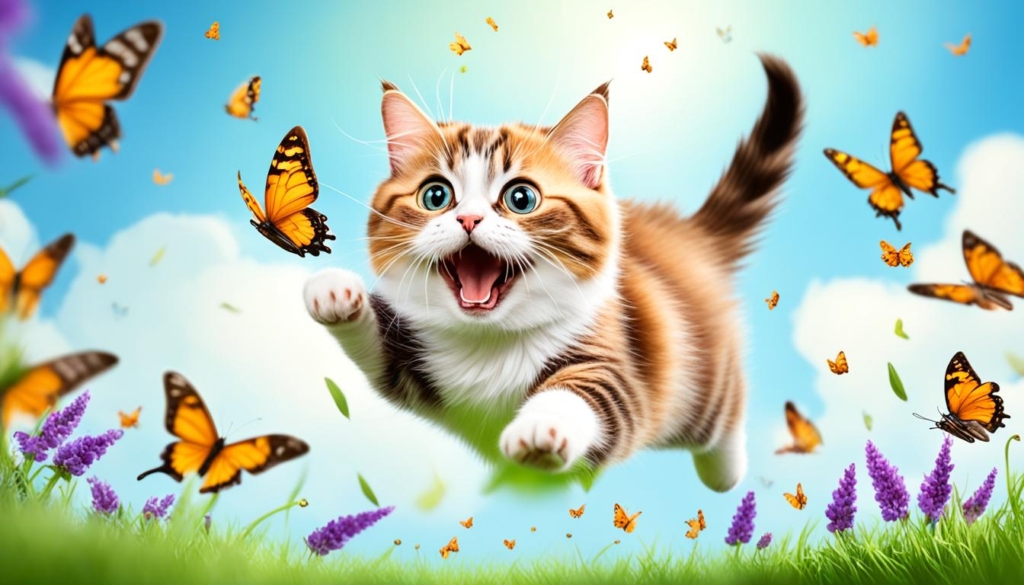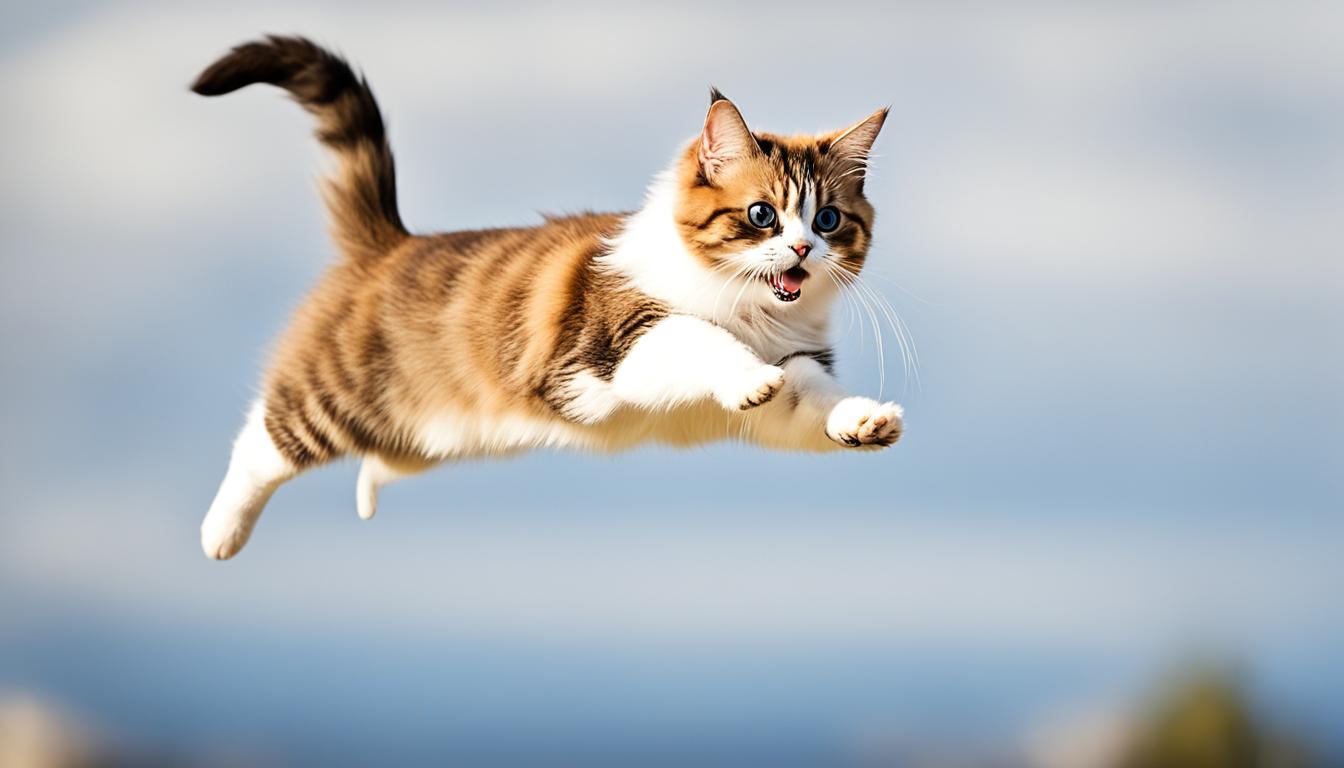Munchkin cats can jump, but they might not jump as high as cats with longer legs. These short cats can still jump up with lots of energy. They use their powerful legs to do so.
It’s hard to say exactly how high they can jump because every Munchkin cat is different. But they can usually jump high enough to reach things like kitchen counters. Things like how long their legs are, their health, and their age can affect how well they jump.
Key Takeaways
- Munchkin cats can jump several times their own height, with some reaching heights close to that of an average cat.
- Factors like leg length variations, overall health, and age impact the jumping abilities of Munchkin cats.
- Despite their shorter stature, Munchkin cats exhibit impressive agility and enthusiasm in their leaps and bounds.
- Providing steps or pet ramps can aid Munchkin cats in accessing higher places safely and reducing strain on their bodies.
- Responsible breeding and proper care are essential to support the joint health and mobility of Munchkin cats.
Origins and History of the Munchkin Cat Breed
The story of the Munchkin cat breed is still a bit of a mystery. Some say they first appeared in 1983 when Sandra Hochenedel found short-legged cats in Louisiana. Others believe they were around in Britain and Russia since the 1940s and 1950s.
The Mystery of Munchkin Cats’ Unclear Origins
There’s not much written history about the Munchkin cat. Their unique look, with a genetic mutation in their legs, has made them interesting to cat lovers everywhere.
Sandra Hochenedel’s Blackberry: The Start of the Munchkin Lineage
Short-legged cats have been seen all over the world since the 1940s. The Munchkin breed was officially recognized in 1991. In 2003, they got TICA championship status. In 2014, a Munchkin cat named Lilieput from California was recorded as the shortest living cat by Guinness World Records.
The Munchkin gene is a dominant gene. When two Munchkin parents have a litter, 25% won’t survive, 50% will be short-legged, and 25% will be normal.
“The disabilities caused by the limb abnormalities in Munchkin cats are present from birth, with affected cats having to adapt and manage the impact throughout their lives.”
The Munchkin cat’s unique look has made them popular. Their origins and genetic mutation are still being studied and talked about in the cat world.
Munchkin Cats’ Physical Characteristics and Unique Traits
Munchkin cats stand out with their short, stubby legs, thanks to a genetic mutation. They have three main leg lengths: standard (a bit shorter), super-short (2-3 inches shorter), and rug-hugger (more than three inches shorter). Despite their small size, they are lively and have big personalities.
Short Legs, Big Personalities: The Munchkin Cat’s Trademark
These cats love to hunt and hide treats for later. They play with the same zest as cats with longer legs. Known as affectionate, sociable, and friendly, they get along well with humans, other pets, and even strangers. They are confident extroverts who love to socialize and explore.
Munchkin cats usually weigh 6 to 9 pounds and are about 5 to 7 inches tall. Their short legs make them stand out, and getting one can cost between $500–$1200. They can easily gain weight, which is a concern. The genetic mutation has raised questions about their health.
Despite their unique looks, Munchkin cats have won the hearts of many cat lovers. Their lively nature and striking looks make them a favorite for mixing with other breeds. This has led to the creation of hybrids like Minskin, Skookum, and Lambkin.
The Surprising Speed and Agility of Munchkin Cats
Many think Munchkin cats move slowly because of their short legs. But, they are actually very fast and agile. They can turn corners quickly, thanks to their great traction and how low they move.
Even with their small size, Munchkin cats move freely and quickly. They are full of energy and love to play and explore. Their speed and agility make them fun to watch.
Munchkin cats are surprisingly quick and agile, despite their short legs. They can move through tight spots and change direction easily. This shows how strong and skilled they are.
“Munchkin cats have this incredible ability to round corners and zip through obstacles with incredible speed and control. It’s almost like they’re on rails!”

Their short legs don’t slow down Munchkin cats at all. In fact, their low stance and strong muscles help them stay fast and agile. They keep up their speed and agility in all their activities and play.
Munchkin Cats’ Jumping Abilities and Limitations
Munchkin cats may look cute with their short legs, but they jump less than cats with longer legs. They got their short legs from a genetic mutation. The International Cat Association (TICA) recognized them in 1994 and made them official champions in 2003.
Can Munchkin Cats Jump? Exploring Their Vertical Leap
A healthy adult cat can jump up to 5 or 6 feet high, which is about 5 to 6 times their own height. Munchkin cats jump less than taller cats but still impress with their leaps. They can jump several times their own height, with the best ones reaching up to 54 inches.
Variations in Jumping Heights Among Munchkin Cats
The length of a Munchkin cat’s legs affects how high they can jump. Standard-legged Munchkins jump like regular cats. But super-short and rug-hugger Munchkins might jump lower. This is because they have a gene that makes their legs short, leading to different leg lengths in the breed.
“Munchkin cats are capable of jumping, although they may have limitations in reaching higher points.”
Potential Health Concerns and Care for Munchkin Cats
Munchkin cats are usually healthy but face some health issues because of their short legs. Their short stature can cause joint stress and lead to osteoarthritis over time. They also often have a spinal condition called lordosis, which can make moving harder.
Joint Issues and Mobility Challenges in Munchkin Cats
It’s important to take Munchkin cats to the vet regularly. This helps catch joint and mobility problems early. Studies show that these cats often have limb deformities and are shorter than regular cats. This makes them more likely to get joint diseases.
Maintaining a Healthy Weight and Lifestyle for Munchkin Cats
To keep Munchkin cats healthy, they need a balanced diet that supports their joints. Feeding them two to three times a day can help avoid obesity, which worsens joint problems. Giving them fun toys and playtime encourages physical activity and keeps them happy.
“Munchkin cats have legs about 3 inches shorter than typical cats, with average weights ranging from 6 to 9 pounds.”
With the right care, Munchkin cats can live happy lives. They can enjoy their favorite activities while staying healthy.
Munchkin Cats’ Playful and Curious Nature
Munchkin cats have a big zest for life, despite being small. They run low to the ground, looking like tiny lions on the hunt. This shows their strong Munchkin cat hunting instincts are still there, even with their short legs.
These cats play just as much as any other breed. They chase toys, jump over obstacles, and show off their agility. Their curiosity makes them explore every corner of their world, just like their wild ancestors.
Stalking, Running, and Pouncing: The Munchkin Cat’s Hunting Instincts
Even though they’re small, Munchkin cats have big Munchkin cat behavior when it comes to hunting. They move fast and agile, looking like they’re gliding over the ground. They stalk prey low to the ground, just like big cats do.
They also love to play and chase toys, showing off their Munchkin cat playtime skills. Their curiosity and playful nature make them stand out.
“Munchkin cats are known for being active, energetic, and playful despite their short legs.”
The Munchkin cat personality is special. They are adaptable, loving, and full of life. Their small size is interesting, but it’s their energy and curiosity that really win people over.

Adapting Your Home for Munchkin Cat Mobility and Safety
Munchkin cats have short legs, so their homes need to be set up for them. If your cat has pain, health issues, or trouble moving, making changes can make a big difference. It helps them live better and stay safe.
Using Ramps, Steps, and Cat Trees for Munchkin Cat Access
Adding ramps and steps helps Munchkin cats get to high places like beds and couches. These tools make it easier for them and keep them from jumping too much. This can prevent injuries. Also, cat trees with steps let them climb safely and feel confident.
Choose ramps and steps with a gentle slope and good grip for your Munchkin cat. Putting these aids near where they like to rest will encourage them to use them. This is good for their health and happiness.
Munchkin cats have short legs due to a genetic mutation. They might not jump or climb as well as other cats, but they can still be active with some changes at home. Making your home Munchkin cat-friendly helps them move around safely and stay independent.
It’s important to take your Munchkin cat to the vet regularly as they get older. This helps check on their joints and deal with any issues early. With the right care and setup, your Munchkin cat can be happy and healthy at home.
The Controversy Surrounding Munchkin Cat Breeding
The Munchkin cat has caused a lot of debate in the cat world. Critics say it’s wrong to breed for a genetic trait that makes cats short. They worry it could harm the cats’ health.
One big worry is the Munchkin cat genetic health concerns. There’s no clear link between short legs and serious health issues yet. But, the long-term effects of this trait are still unknown. Munchkins often have a condition called “lordosis,” which can hurt their organs.
There’s also a lack of Munchkin cat adoption awareness. Some think breeding more Munchkins is not right, given the many cats already in shelters. In the UK, about 150,000 cats find themselves in shelters each year, from kittens to seniors, and various breeds.
“Breeding a munchkin cat with a normal cat offers a 50/50 chance of producing another munchkin cat. When breeding two munchkin cats, their offspring won’t survive due to the munchkin gene being ‘fatal.'”
The debate on Munchkin cat breeding ethics is ongoing. If you’re thinking of getting one, do your homework. Look into adoption and choose a responsible breeder who cares about the cats’ health. A breed selector tool can help find the right pet for you.
Munchkin cats have been around since the early 1940s but got official breed status in 2003. They are known for their very short legs and long spine. This unique look has drawn both praise and concern.
As Munchkin cats become more popular, we need to talk openly about their breeding. We should focus on their health and well-being. This way, we can make sure they are treated with care and respect in our homes and communities.
Conclusion: Appreciating Munchkin Cats’ Unique Qualities
Munchkin cats may not jump as high as other cats, but they offer so much more. They have big personalities, are always curious, and are very fast and agile. These traits make them a great addition to many homes.
Before getting a Munchkin cat, it’s important to think about their needs and limitations. You should make sure you can give them a safe and happy home.
By valuing the Munchkin cat’s unique qualities, we support responsible breeding and ownership. These small but lively cats have won many hearts. With the right care, they can live happily with their owners for many years.
The Munchkin cat’s charm comes from their fun behavior and loving nature. By understanding and meeting their needs, we show our appreciation for this special breed. This helps them stay loved and accepted by cat lovers everywhere.


